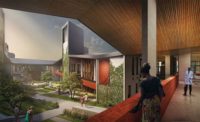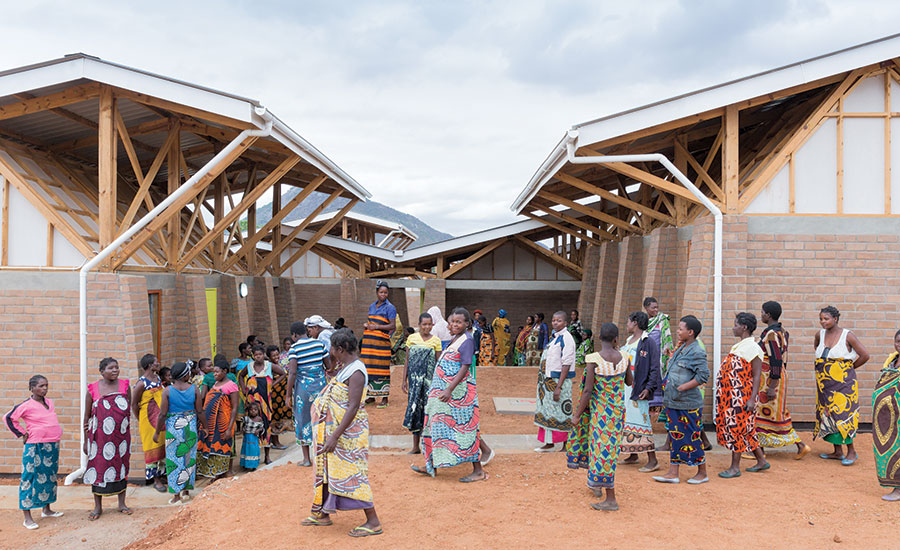Kasungu Maternity Waiting Village by MASS Design Group
Malawi

Expectant mothers often arrive in the company of two or three “guardians”—female relatives who help care for the women while they wait.
Photo © Iwan Baan

Designed with this tradition in mind, the buildings’ extended awnings create sheltered exterior spaces to accommodate many more than just the 36 temporary residents.
Photo © Iwan Baan

Tapered columns and benches built into building exteriors serve as comfortable outdoor seating areas.
Photo © Iwan Baan

Expectant mothers and their guardians cook in area just outside the perimeter of the waiting village.
Photo © Iwan Baan

Expectant mothers and their guardians cook in the communal kitchen.
Photo © Iwan Baan

Image courtesy MASS Design Group






Architects & Firms
Against the backdrop of a brush-covered hilltop in central Malawi, women in brightly colored clothing gather to cook, chat, or simply rest amid a cluster of small buildings that rises from the sparsely vegetated landscape. Boston-based MASS Design Group’s latest project—a “maternity waiting village” near the Kasungu District Hospital—aims to address high infant and maternal mortality rates by placing high-risk expectant mothers in close proximity to medical professionals during the final weeks of pregnancy.
Densely populated but largely rural, Malawi, in southeast Africa, is one of the most dangerous places in the world to give birth: many women must travel long distances from remote areas to reach medical providers, and nearly seven mothers and 50 infants die for every 1,000 live births, So-called maternity waiting homes, located near hospitals or health centers, can dramatically improve chances for a successful delivery.
MASS, founded in 2008 by Michael Murphy and Alan Ricks, is known for humanitarian projects, including the Butaro District Hospital in Rwanda, the GHESKIO Cholera Treatment Center in Haiti, and the Ilima Primary School in the Democratic Republic of Congo. In 2013, the firm joined with multiple partners—including the Malawi Ministry of Health, the University of North Carolina, the Bill and Melinda Gates Foundation, and the Autodesk Foundation—in responding to a presidential initiative that called for the construction of 130 maternity waiting homes throughout the country. Though the Ministry of Health had already approved plans for a bare-bones prototype (a barn-like structure, dark and poorly ventilated, with 36 beds separated by partitions), MASS began investigating ways to create a new model designed in the regional vernacular that would better meet women’s needs while staying close to the $100,000 budget.
“We asked ourselves, ‘How do we transform a waiting experience into an empowering experience?’” says MASS director Patricia Gruits, who led the project with Christian Benimana. “How do we make it not only safe, healthy, and comfortable, but build community and dignity? That’s what drove our design.”
The team conceived of the waiting village as a cluster of small, separate buildings. Riffing on the traditional Malawian home, their scheme comprises three units of three rooms each, with four beds per room. It also increases the number of bathrooms, placing two toilet/shower facilities in every 12-person unit, for a total of six—two more than the Ministry’s prototype.
Covered pathways connect the units to one another and to shared spaces (a kitchen, medical consultation and screening room, and classroom), providing shelter from the harsh sun and heavy seasonal rains, while also fostering a sense of community. Design team member and on-site construction manager Jean Paul Sebuhayi Uwase explains, “In Malawi, people spend most of their time outside, chatting and doing chores, so we created courtyards and added overhangs and benches to the exteriors, to make space for people to interact.”
Local workers constructed the buildings with compressed stabilized earth blocks (CSEB)—a budget-friendly move that also addressed environmental concerns. Under Sebuhayi’s direction, laborers fabricated the soil-and-cement blocks using a press that MASS then left behind for future use. “In Malawi, it’s not easy to find good bricks,” he says. “It was important to teach the workers this new skill.” Additionally, deforestation is a major concern for the country; unlike traditional bricks, CSEBs are not fired, eliminating the need for kindling.
MASS did use wood for the trusses supporting the sheet-metal roofs—though it wasn’t easy. “The wood locally available was of a quality that made it difficult to meet our structural demands,” says Gruits. “But Jean Paul worked with laborers on-site to perfect a technique of joining pieces together to get the strength we needed.”
The team designed the roof geometries with the region’s fluctuating climate in mind. Direct sunlight does not enter windows, keeping buildings cool during the daytime, but strikes the upper portions of the tall masonry walls, which passively warm the buildings when temperatures drop at night. Sharply angled and connected by gutters that channel rainwater into the village’s catchment system, the roofs are also equipped with solar panels to power the lights.
The Kasungu Maternity Waiting Village—open just since the fall of 2015—could become the new prototype for this type of facility in Malawi and other countries across Africa, and the MASS research team is launching a qualitative and quantitative evaluation study to understand how the design has impacted both mothers and babies. “We’re working to make this as affordable as possible,” says Gruits, “and to get the proof that design can improve health outcomes.”










